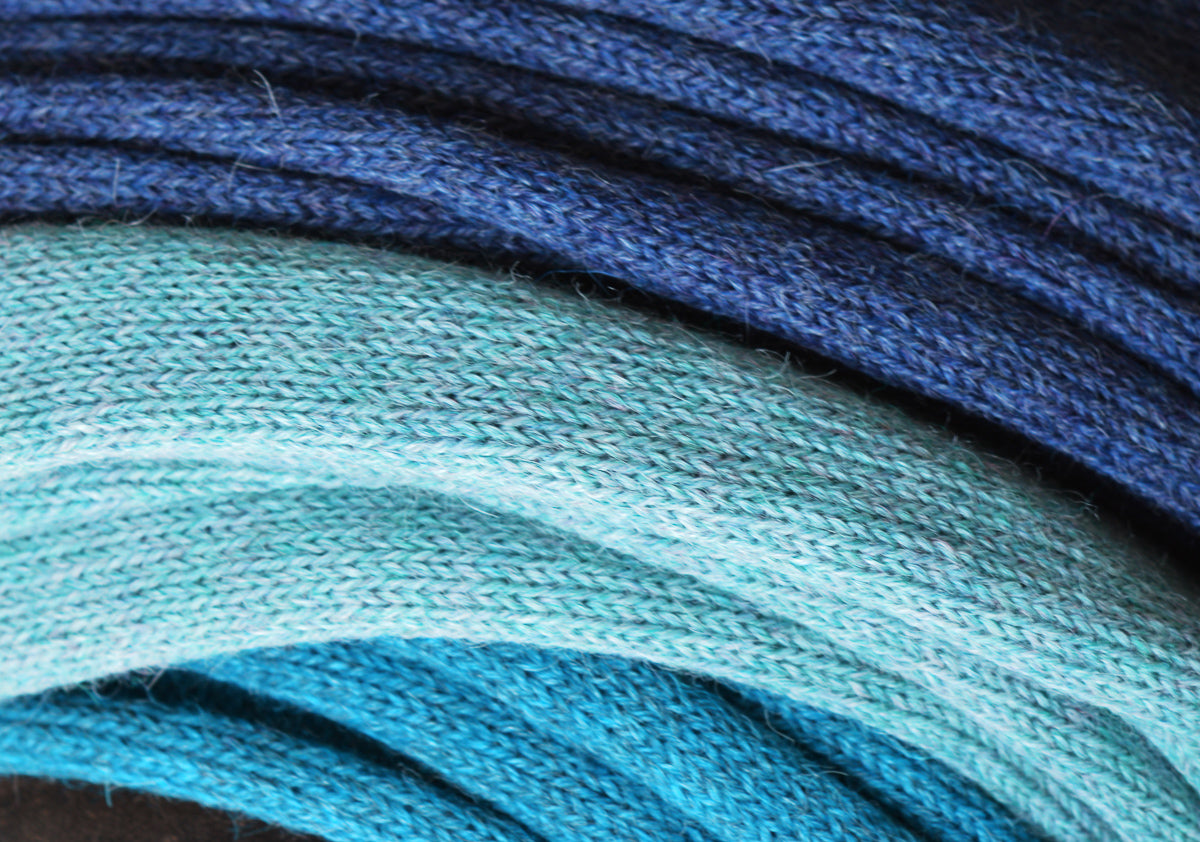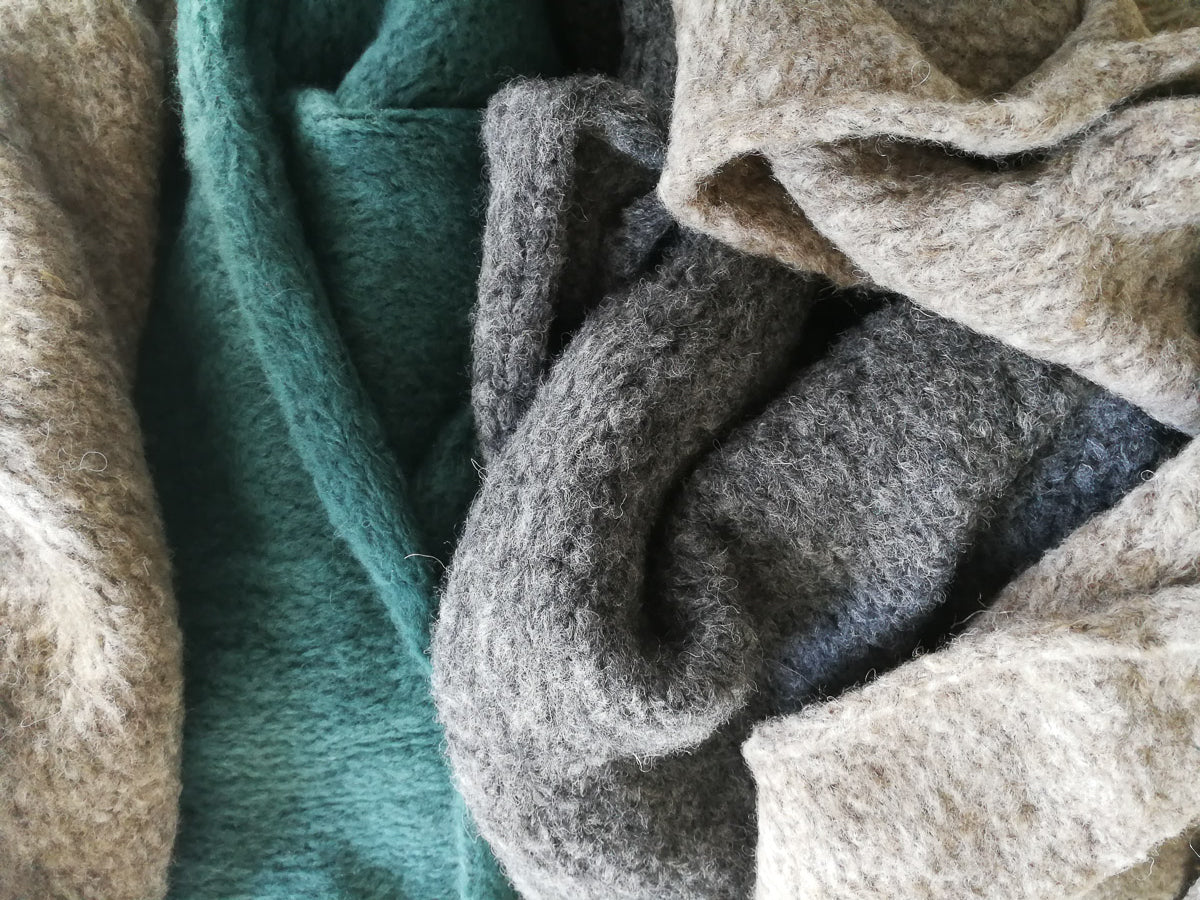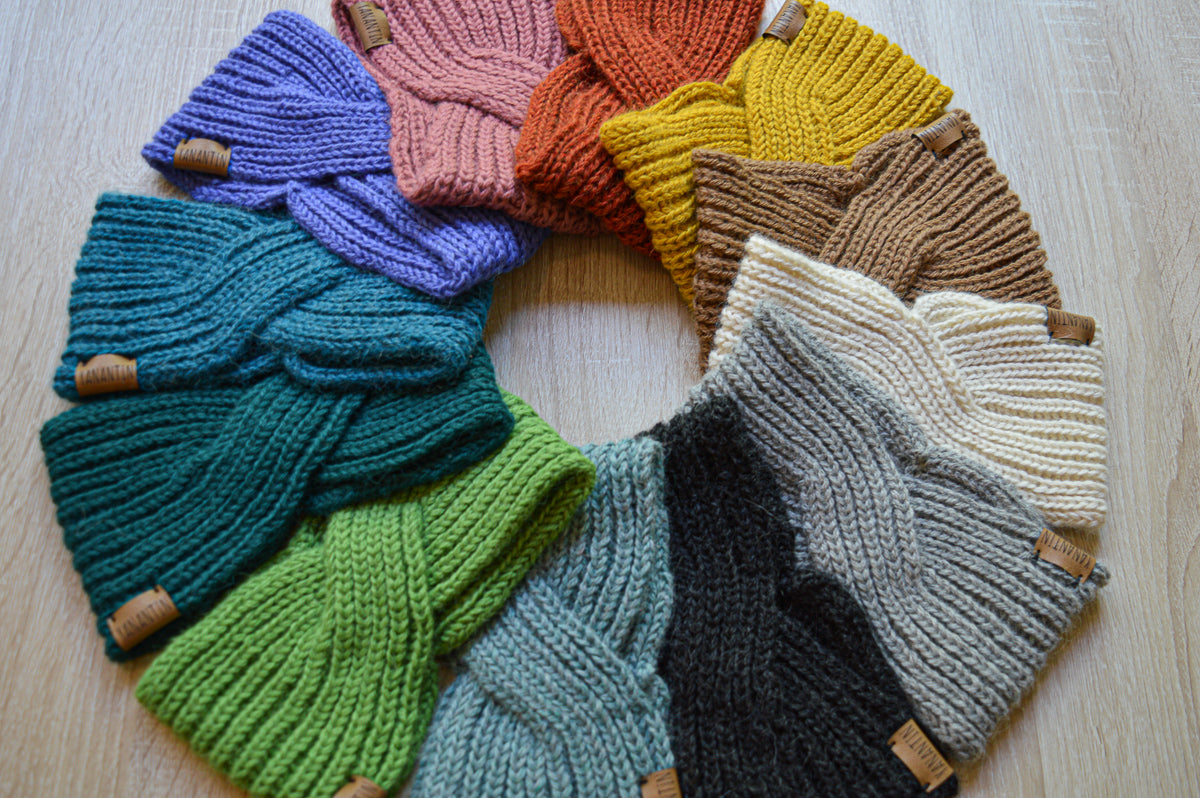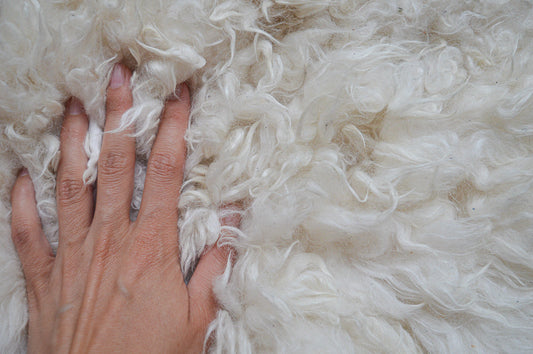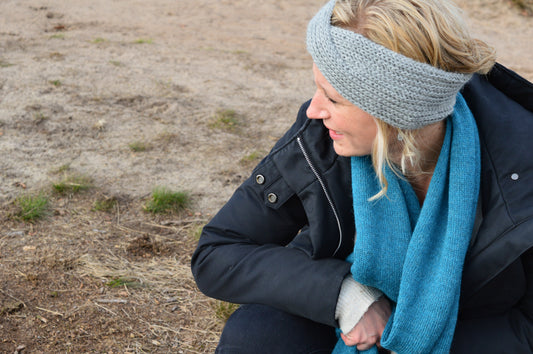Windproof. Odor-resistant. Practically stain-proof (yes, even red wine). Alpaca wool isn’t just soft, it’s a powerhouse of performance. Dive into this article, if you’ve ever wondered: What are the features of alpaca wool?
Alpaca wool is a high-quality fiber with unique qualities. Here is a list of benefits attributed to alpaca wool
Durable
Alpaca wool is durable because of many different reasons:
-
Strong Fibers: Alpaca wool is naturally strong, resisting breakage and wear over time.
-
Pill-Resistant: The smooth fibers prevent pilling, keeping your garments looking new longer.
-
No Wear and Tear: Alpaca wool holds its shape, resisting fuzziness and distortion, even with frequent use.
-
Elastic: It stretches and bounces back, maintaining its fit without sagging or losing shape.
-
Shrink-Resistant: Less prone to shrinkage, alpaca wool keeps its size and fit after washing.
-
Water-Resistant: Natural water resistance helps alpaca wool stay durable in damp conditions.
When a garment is durable, it means that they last longer before showing signs of wear and tear. Unlike most other wools, alpaca doesn’t pill easily. No annoying fuzz balls under the arms or along high-friction zones. It keeps its smooth, elegant look for years. Yes, even with regular wear.
-
At markets, people often share that they have an alpaca sweater or coat that belonged to their grandparents—and STILL looks amazing. Talking about slow-fashion!
When properly cared for, alpaca garments can last decades without losing their shape, shine, or strength. Want to make yours last a lifetime? Check out our alpaca care guide.
Elastic
Alpaca wool is elastic with memory. This means it moves with you, stretching and adapting to your movements, then bouncing back to its original shape. Whether you’re lounging or on the go, it stays comfortable and retains its form, keeping you looking sharp and feeling great all day long.
This feature is great for all-day comfort, because when you wear alpaca wool it won’t feel restrictive. Similarly, alpaca wool adapts to your body without losing its form, giving you that perfect, comfortable fit every time you wear it (while looking great).
However, when a garment gets wet, you DO need to be careful. The extra weight can actually permanently mess with its shape.
-
Pro tip: Remember to dry alpaca wool flat after washing it.
Fire-Resistant
Alpaca fiber is naturally more flame-resistant than many other fibers, meaning it’s much less likely to catch fire. Unlike plant-based or synthetic fibers, which are highly flammable, alpaca wool won’t ignite easily.
Note: While no fiber is completely fireproof, if you accidentally get too close to a candle, your alpaca garment won’t go up in flames immediately. Plus, unlike synthetics, alpaca won’t melt onto your skin if exposed to heat.
Hypoallergenic (Allergy Free)
Alpaca wool is naturally hypoallergenic, making it a fantastic option for people with sensitive skin or wool allergies. Unlike sheep wool, alpaca doesn’t contain lanolin, which can cause irritation for some.
But lanolin is not the only allergy-causer: alpaca wool also has fewer scales than other types of wool, reducing the amount of irritating friction on the skin. Additionally, alpaca fibers produce less dander, which is another major cause of allergic reactions in some individuals.
So, if you experience itching, rashes, or respiratory issues from traditional wool, alpaca is a gentler alternative.
For more information on alpaca wool's hypoallergenic properties, check Healthline or consult dermatological studies on wool allergies. (And of course: always consult your doctor. This information does not replace medical advice.)
Insulating
Alpaca wool is naturally insulating, thanks to its hollow fibers. Alpaca fibers contain tiny pockets of air, like little built-in airbags. These air pockets trap heat, helping to keep you warm in cold conditions.
-
The Real-Alpaca-Experience: This is the same mechanism that helps an alpaca stay cozy in freezing temperatures, even in the high Andes.
When you wear alpaca wool, its hollow fibers trap heat from your body, creating a warm, insulated layer that helps maintain a comfortable temperature. A nice comfortable temperature to keep you warm and comfortable no matter the weather.
Isolating
Alpaca wool is also isolating, meaning it acts as a natural barrier, protecting you from the elements. Its hollow fibers don’t just trap heat; they also block out cold winds, rain, and even the harsh sun.
-
The Real-Alpaca-Experience: Ever been to the Peruvian highlands? The whether gets pretty extreme up there: from slashing winds to out-of-the-blue downpours, altered with burning sun.
Just like an alpaca’s thick coat shields it from the wind and rain, your alpaca wool garment will help keep you protected, whether it's sunny, rainy, or windy.
The Science Behind It
Alpaca wool’s fiber structure plays a key role in blocking out wind and rain. The fibers are naturally smooth and water-resistant, which helps prevent moisture from getting through. The hollow core traps heat for insulation, while the outer structure of the fibers helps act as a barrier, keeping wind and rain at bay.
Itch-free (for Most)
For most people, alpaca wool feels without any itch at all. Its soft scales and high-quality fiber are gentle on the skin. I say “most people” though, because if you have sensitive skin, regular alpaca wool will leave you feeling itchy.
But don’t be disappointed: if you see a garment made with baby alpaca, that will most likely be totally itch-free for everyone. Baby alpaca is even softer than regular alpaca wool.
If you’re into details about fiber thickness, here’s the breakdown:
- Alpaca wool is generally around 24–26 microns,
- Baby alpaca is around 21–23.
- Anything above 30 microns is itchy for everyone...
- 20–30 microns is the in-between area in which most people won’t feel an itchy, unless you have sensitive skin.
Are you itching to learn more? Read about it my article: Is Alpaca Wool Itch-Free?
Lightweight
Alpaca is insulating but lightweight, making it a perfect material for those who want warmth without the weight.
Alpaca fibers are smooth and hollow in the center. This hollow structure allows the fibers to trap heat efficiently, providing insulation without being heavy. Additionally, the fibers are thin and smooth and this makes alpaca wool perfect for cozy garments that don’t feel heavy or cumbersome.
Lightweight vs. Light in WeightAlpaca wool is naturally more insulating than regular wool due to its hollow fibers, which trap more air and heat. As a result, to achieve the same level of warmth, a scarf made from regular wool would need to be thicker or heavier—potentially weighing twice as much as an alpaca scarf to provide the same warmth. However, if both scarves were the same weight, the alpaca wool scarf would keep you warmer. Its fibers are more efficient at trapping heat, meaning alpaca wool delivers more warmth with less material. This makes it a lighter, more efficient option for insulation. |
Natural Colors
Alpaca wool is available in 22 natural colors. Yes, twenty-two. Twenty-four even, depending on who you ask.
From pitch black to pure white and everything in between, they are the natural, raw hues that alpacas come in. Who’d ever known there were so many different shades of grey, black, brown and white?

Beyond just the visual appeal, the natural color range of alpaca wool also brings a happy environmental benefit. By using wool that comes in these natural shades, there's no need to rely on synthetic dyes, which can often be harsh on the environment.
-
COOL! The white, brown, grey, and black shades you find in the Yanantin webshop are all undyed and biodegradable.
Odor-Resistant
Natural alpaca wool doesn’t absorb smells easily. What a random feature, you might wonder?
Here’s where it comes in handy: you’ve been hiking, camping, lounging for days. And all the while you’ve been wearing your favorite alpaca wool. Non-stop (no judgement, I do it, too).
Now, would you dare to smell it?
The amazing thing is that with alpaca wool, you don’t have to worry. Despite all the sweat, dirt, and (lack of) fresh air, your alpaca wool items won’t absorb any of those smells. Thanks to the wool’s natural ability to regulate air and wick away moisture, it stays fresher for much longer than other fabrics.
So, go ahead—wear it as long as you like. No need to worry about smells taking over.
-
Pro-tip: To freshen up your alpaca wool, hang it in a steamy room (like after a hot shower). The steam helps release any odors and keeps it smelling fresh.
Soft
Alpaca wool is soft. Soft, soft, oh-so-soft! Alpaca wool feels like warm and fuzzy hugs. It’s really great.
This is due to several key factors:
-
Finer Fibers: Alpaca wool fibers are much finer than traditional sheep wool, with an average diameter of 18 to 30 microns. In comparison, most sheep wool ranges from 25 to 40 microns. This finer fiber structure contributes to a softer feel.
-
Smooth Texture: Alpaca fibers are naturally smoother with less crimp than sheep wool, meaning they don’t have the rough, scratchy texture that often leads to itchiness.
-
Lack of Scales: Unlike sheep wool, alpaca fibers lack the microscopic scales that create friction against the skin, preventing irritation and itchiness.
-
Hypoallergenic: Because of its smoothness and finer texture, alpaca wool is hypoallergenic, making it an excellent choice for people with sensitive skin or wool allergies.
Stain-Resistant
Alpaca wool has some natural stain-resistant qualities. Its fibers are water-resistant to a certain extent, which means they don’t absorb moisture as quickly as some other materials. This helps to prevent stains from setting in immediately.
Additionally, alpaca wool’s smooth, fine fibers make it harder for dirt and liquids to cling to the surface compared to coarser wools.
However, it’s important to note that while alpaca wool has some natural resistance, it’s not completely stain-proof. It's still a good idea to treat stains quickly to prevent them from setting.
Strong
Alpaca wool is one of the strongest natural mammal fibers in the world (some even argue it’s the strongest, though that’s still up for debate).
Without getting too technical, here’s how it works: its strength comes from the long, smooth fibers unique to alpacas, which have less friction and are less likely to break. When fibers are spun into yarn, it makes alpaca even stronger.
Strong fibers are awesome because they make your garment last longer.
Sustainable for the Environment
Alpacas are naturally low-impact animals. They graze without uprooting plants, allowing vegetation to regrow, and their soft, padded feet don’t damage the soil. Compared to other livestock, their carbon footprint is minimal. Alpaca wool itself is biodegradable, renewable, and requires little to no chemical processing.
From how the animals live to how the fiber is produced, alpaca wool is a sustainable choice from start to finish.
Slow-Fashion
Alpaca embodies everything slow-fashion stands for. Good for the planet = good for you.
And that is a win for your wardrobe.
It’s strong, resists pilling, repels odors and stains, and barely needs washing—cutting down on water and energy use. Most of the time, a simple airing is all it takes to freshen up your piece. And since it lasts for years, you’re buying less and wearing more.
You’ll wear it more, wash it less, and love it longer.
-
Are you ready to invest in quality over quantity? Visit our Webshop!
Water Repellent
Alpaca wool is water repellent, which means rain and any type of moist will be shed from the surface, not soaked up.
-
Let me be straightforward here and immediately confess that alpaca wool is not waterproof. If you drench the wool in a bucket of water, it will definitely be soaked to the core.
However, alpaca wool is known to be super water repellent so that when you’re caught in an unexpected downpour, raindrops stay on the surface and don’t absorb easily.
My experience? Whenever I head out, I bring my XL alpaca scarf. The moment the raindrops start falling, I’ve got a makeshift umbrella ready. And when the rain stops, I just shake off the water: good (and dry) to go.
Wind-Resistant
Alpaca wool is naturally wind-resistant, making any scarf or sweater perfect for… Anything, really. If it can keep an alpaca warm in the brutal Andean highlands, it can definitely handle your morning commute. The fiber itself blocks out wind, making scarves and sweaters feel like a cozy shield.
Knitted alpaca items (like scarves or sweaters) can be wind-resistant, but it really depends on how tightly they're knit. A dense stitch will block more wind, while a looser knit will let more air through.
Woven or felted alpaca, on the other hand, offers much stronger wind protection. The tighter, more compact structure makes it harder for air to get through, giving you a built-in barrier against the elements.
Still, my scarf is my bestie, come wind, rain or shine :)

Wrinkle-Resistant
Alpaca wool is wrinkle-resistant. Yes, products made with alpaca do not wrinkle. No matter how badly folded or crushed an item may be, by simply unfolding your item, it will unwrinkle without any further effort: simply wearing it often does the trick.
Stretched out from a long day, or left unfolded in the corner of the room (no judgment, we've all been there)? No need to break out the iron. Alpaca wool doesn’t hold onto creases. No matter how crumpled or folded they get.
The science behind it? That strong fiber, smooth structure, and lightweighted-ness.
-
Pro-tip: Alpaca wool is the perfect travel companion. Stuff it in your backpack or toss it in your carry-on… When you’re ready to wear it, it’ll be warm, cozy, and wrinkle-free.



